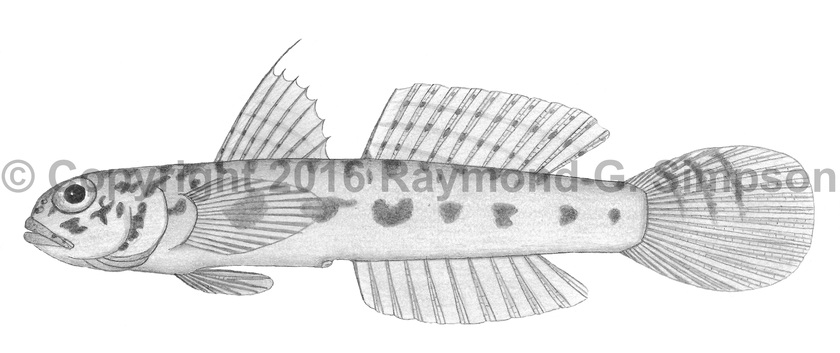
Common Name
Bluntsnout Goby
Year Described
Smith & Baldwin, 1999
Identification
Dorsal Fin: VII, 11-12
Anal Fin: 9-11
Pectoral Fin: 17-19
Caudal Fin: 17 segmented rays
Vertebrae: 11+16= 27 (total)
Body elongate with a steep, blunt frontal profile. Snout short. Eye medium sized. Dorsal fin with anterior spine elongate. Pelvic fin rays branched with the last shorter than fourth ray and branched in adults. Pelvic fins not fused but with a small membrane connecting them basally. Caudal fin oval with middle rays longer. Two anal-fin pterygiophores anterior to the first haemal spine. Cephalic lateralis pores absent. Body naked. Belly unscaled. No basicaudal scales.
Color
Color in life not described. Body yellow-brown in alcohol with around 16 brown saddles on the dorsum and several irregular lateral blotches not connected to the saddles. Head with numerous spots and blotches. A bar usually present from the pectoral axil to the dorsal origin. Dorsal fin clear with small dark spotting. Pectoral and pelvic fins clear. Tail with three slanted dark bars.
Size
Maximum size to 44mm SL.
Habitat
Associated with shallow sand flats and seagrass beds in the vicinity of coral reefs (<6m).
Range
Endemic to the Belize barrier reef system in the W. Caribbean Sea.
References
Smith, D.G., & C.C. Baldwin. 1999. Psilotris amblyrhynchus, a new seven-spined goby (Teleostei: Gobiidae) from Belize, with notes on settlement-stage larvae. Proceedings of the Biological Society of Washington, 112(2): 433-442.
Tornabene, L., J.L. Van Tassell, R.G. Gilmore, D.R. Robertson, F. Young, & C.C. Baldwin. 2016. Molecular phylogeny, analysis of character evolution, and submersible collections enable a new classification of a diverse group of gobies (Teleostei: Gobiidae: Nes subgroup), including nine new species and four new genera. Zoological Journal of the Linnean Society.
Other Notes
This species was removed from Psilotris by Tornabene et al. (2016) to resolve the polyphyly of that genus, and the new genus Carrigobius was erected. It is diagnosed by a combination of the blunt snout, branched fifth pelvic ray, and 2 pterygiophores preceding the first haemal spine.